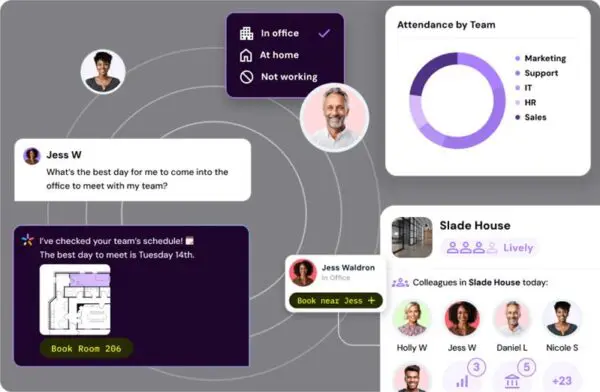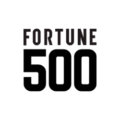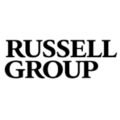The Top Three Hybrid Work Challenges and How to Solve Them

Even the most positive changes create their own set of challenges, and hybrid work is no different.
For example, the invention of modern rail travel – for all its benefits – created a challenge. Different cities and towns ran on their own slightly different times, resulting in late trains, passenger confusion and even accidents. This challenge was a non-issue before the advent of the modern railway system.
To overcome it, Britain’s rail companies standardized on Greenwich Mean Time, leading to its global adoption as the reference point for time zones, the standard definition of the second, and the invention of the atomic clock decades later. Today, the atomic clock is responsible for not only accurate timekeeping but GPS accuracy.
Hybrid workplace leaders and employees are finding themselves in a situation that isn’t dissimilar to that of railway companies and passengers in 19th century Britain.
Despite the positives hybrid work has created – better job satisfaction, better work-life balance, enhanced wellbeing, productivity and so much more – hybrid work as a system hasn’t been optimized just yet.
Miscommunications happen, different parts of workplace strategy lag behind, and incorrect decisions are made based on inaccurate information.
And considering that 80% of companies have a hybrid work program, ironing out the challenges is quickly becoming a priority.
Here are the top three hybrid work challenges workplace leaders are facing in 2024.
1) The workplace experience-occupancy correlation conundrum.
Why should I go into the office when it takes more effort, costs me more money, and I can get my work done just as well working remotely?
Why should we invest in incentivizing more people to come into the office when no one comes in in the first place?
Herein lies the conundrum. The quality of an organization’s workplace experience is intricately linked with the number of people who come in. If employees see no reason to come into the office, that creates a bad workplace experience. And even if an organization does improve their workplace experience, if no one knows about it, no one comes in. That means it’s still a bad workplace experience.
So are strict return-to-office mandates the answer? Not necessarily. 42% of employees in a recent survey said the only reason they returned to the office was to be more visible to management. Not exactly the productive, collaborative environment workplace leaders are hoping for.
Looking at this conundrum from the employee side, the resistance to office attendance makes perfect sense. Employees spend an average of $561 per month extra on returning to the office, only to find empty space most of the time. 55% also report feeling more lonely since moving to a hybrid work pattern.
The challenge is giving employees a reason to come into the office, so attendance is purposeful rather than forced or superficial, then communicating those reasons to the employee base, wherever they’re working from. Once the office provides a different, better experience than working remotely, occupancy increases.
3 Things Destroying Social Connection in Your Hybrid Workplace
If you’re looking to build social connection in your office and have one or all of these 3 things going on, you’re doing more harm than good.

2) Understanding workplace patterns and preferences.
Which spaces should we get rid of? Are any of our office neighborhoods close to capacity? Are we allocating space fairly to each department?
Answering these questions is hugely challenging when hybrid work patterns are as unpredictable as they are. 61% of companies are using an expectation-based hybrid schedule – in other words, a schedule where employees are expected to be in the office a minimum number of days per week (e.g. three) but the days aren’t specified. That usually results in overcrowded spaces on Tuesday, Wednesday and Thursday, but ghost towns on Monday and Friday.
So when the time comes to cut or repurpose space, what stays, what goes and what should change? Costly, impactful real estate decisions like downsizing and acquiring more square footage are all being made blind without quantifiable workplace data. Blind decision making can cost millions if not billions if real estate choices don’t pan out as intended.
And another big challenge – how can workplace leaders measure the success of hybrid policies, office design and layout changes? 22% of HR leaders report that their organization doesn’t have any metrics to track the success of return-to-office initiatives.
What’s more, without a way to understand and measure changing workplace patterns, the performance of new renovations, amenities and perks will remain a mystery. Continuous improvement is impossible without a reference point to start from.
5 Space Utilization Metrics for a Better Workplace in 2024
Measure these 5 space utilization metrics to cut costs, improve employee experience and make real estate portfolio decisions with certainty.

3) Hybrid work moves fast, but workplace changes move at a glacial pace.
Workplace patterns change as quickly as a bullet train. But most offices change at the pace of a steam engine.
There’s two reasons for this.
Disparate data makes it all but impossible to match employees with different hybrid schedules to the right workspaces.
Back in the day, one employee occupied one desk five days per week – a sharing ratio of one to one. But today, three employees occupy one desk at different times over a week – a sharing ratio of three to one. Add in permanently assigned desks, focus pods, collaboration spaces and more, and those sharing ratios get pretty complex to manage and change. 69% of hybrid companies plan to increase seat sharing ratios, according to a recent JLL study. But without a way to match up data on each employee’s hybrid persona (e.g. the in-office keen beans, two days per week crew, teams who come in on the same day every week, etc) with the sharing ratio of each space, chaos ensues.
Secondly, shifting to hybrid has created departmental silos.
Workplace experience is still a relatively new concept, because before the advent of hybrid work, it was the only experience employees had. Now, a great workplace experience isn’t just a plus, it’s a must. Improving it falls under the domain of HR, IT, Operations, Facilities Management and CRE teams, plus newer roles like Workplace Experience and Strategy. For these teams, cross-functional collaboration is still new, and only 1% or organizations surveyed have a hybrid change management program that involves Facilities Management and Workplace Strategy teams.
When relevant departments aren’t working in sync and sharing data, change stalls. Hybrid work is change, so when change stalls, the ship sinks.
How to fix these challenges
84% of workplace leaders are still struggling to optimize their hybrid work models and overcome hybrid work challenges.
And it’s no surprise – hybrid optimization involves a shift from static workplace management to dynamic workplace management. Solid and predictable work patterns have morphed into fluid, unpredictable work patterns. Workplace leaders need a cohesive, holistic approach to staying agile during constant change.
That’s why we’ve developed the first ever hybrid optimization platform – HubStar H<sub>2</sub>O.
The first ever hybrid optimization platform
Workplace experience, portfolio optimization and cost reduction - H2O helps you bring it all together.

Share this post
Similar posts


















